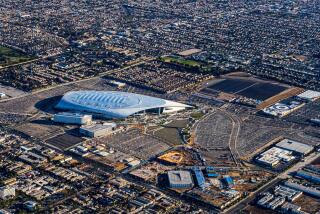Roars From Douglas’ Tests of Jet Engines Bring Protests
- Share via
LAKEWOOD — At Ed Roebuck’s house on Warwood Road just east of Paramount Boulevard, vibrations from the noise are so intense that the putty in his sliding glass doors “jumps out,” Roebuck says.
At nearby Lakewood County Golf Course, the snarling roar shakes the pro shop and sends blood pressures spiraling. “You can be playing on the seventh green and practically fall over when (the noise) stops,” golf pro Tom Petersen says.
On Greenmeadow Road, 20-year resident Richard Depperman says the noise is getting so bad he bought a device to measure sound levels.
And the city of Lakewood--worried about a growing number of complaints--has hired a consultant to study the problem.
The roar that has for years periodically engulfed the southwest corner of Lakewood and parts of Long Beach occurs when nearby Douglas Aircraft tests the jet engines on its new airplanes.
The tests, residents say, can last for up to 30 minutes, shaking buildings, drowning out the sound on their televisions and making conversation impossible. The area most affected, according to residents, stretches north from the Douglas test site to Del Amo Boulevard and is bounded roughly by Lakewood and Paramount boulevards on the east and west.
Roebuck, an avid golfer, says he is particularly upset that the testing position of the jet planes sends exhaust and noise directly over the county golf course.
“You can smell the jet fuel all over the golf course. . . . I just think it’s terrible that (it) has to absorb all that punishment,” Roebuck said. Even though his house is built next to the golf course, he said, he often plays on other courses to avoid the sound and smell of the engine tests.
“The whole situation is that Douglas is a sacred cow,” says Roebuck, a former Dodgers pitcher who scouts for the Cincinnati Reds. “Nobody wants to give them a hard time. They employ a lot of people around here.”
Since 1940, the Douglas plant has straddled the border between Long Beach and Lakewood and sprawled out around the runways of Long Beach Airport, another noisy neighbor. An estimated 35,000 people work at Douglas, a division of McDonnell Douglas.
The Long Beach Airport receives about seven calls a month from Lakewood residents complaining about the Douglas testing, said Rod Dinger, the airport’s senior noise control specialist. In November, Long Beach residents also filed 23 complaints about the noise. Overall, the airport received 119 complaints in November about noise from flights at the airport and Douglas testing.
The city of Long Beach, which leases parcels of its airport property to Douglas, has limited testing. Douglas is allowed to test planes between 7 a.m. and 9 p.m. on weekdays. No testing is allowed before 9 a.m. on weekends.
The airport, said Dinger, is exploring the possibility of moving the test site from the edge of the airport property toward the center and perhaps building a hangar for the testing. However, he emphasized that the idea is in the exploration stage, and that it would take two years to get the necessary approvals from the city and the federal government before a hangar could be built.
Donald N. Hanson, Douglas’ manager of public relations, said: “We have done what we can to keep the noise down. We try to be as accommodating as we can, but at the same time we have to go on producing aircraft.”
The consultant, Thomas W. Fitzwater of Michael Brandman Associates in Santa Ana, says he has had little luck in getting Douglas to be specific on how many hours a week it tests. However, the firm did give Fitzwater some advance notice on tests so that he could record the decibel levels produced by the tests.
Resident Depperman says he has learned from talking to people who know the industry that an engine must be tested eight hours before being handed over to its new owner.
But Hanson, the Douglas spokesman, said the test hours can vary significantly.
Before a plane takes flight, Hanson said, the engine is tested on the ground at various thrust levels until it functions smoothly at each level. “Sometimes it takes a few minutes, sometimes a lot longer,” Hanson said.
The plant, according to Hanson, is turning out its MD80, a twin engine commercial jet transport plane, at a rate of 2.5 per week.
Chuck Ebner, Lakewood’s planning and development director, acknowledged that Douglas’ economic position in the community has helped insulate the company from public criticism. The insulation, however, may be unraveling because of accelerated production schedules and new airplane designs.
Both Fitzwater and Depperman point out that Douglas has also started producing its MD11, a model that has a third engine mounted on the plane’s fuselage. They believe that the third engine is adding to the noise problem because the engine is higher than the massive concrete slabs, known as blast fences, that are positioned along the testing field to deflect jet exhaust and sound.
Fitzwater says the fences are used primarily to catch debris and do little to reduce noise. But Hanson says Douglas started testing MD11s only a couple weeks ago, that the third engine is not higher than the blast fence and that the fences do deflect noise.
Hanson also pointed out that peak production for the plant was reached in the early ‘70s and that Douglas has produced other models that had third engines on the fuselage. He also noted that new federal noise restrictions have resulted in quieter engines than were produced a decade or two ago.
The noise complaints, Hanson said, usually occur on days when there are atmospheric conditions that hold the noise down and push it outward. “It depends on the winds, the temperature and even the cloud cover sometimes,” he said.
In the course of its study, Lakewood has discovered that the current Douglas test site lies within the city’s municipal boundary, though the Long Beach Airport owns the parcel and leases it to Douglas. Lakewood and its consultant, Ebner said, are exploring what legal steps the city can take to reduce test noise that originates within municipal boundaries.
Though he has not yet completed his report to the Lakewood council, consultant Fitzwater said possible solutions include requiring that tests be conducted in a building, moving the test site to another location, imposing stricter time limits on testing, or using new materials in sound barriers to help control noise.
More to Read
Sign up for Essential California
The most important California stories and recommendations in your inbox every morning.
You may occasionally receive promotional content from the Los Angeles Times.










